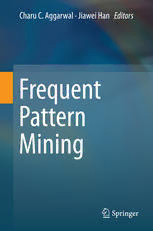Table Of ContentFrequent Pattern Mining
Charu C. Aggarwal • Jiawei Han
Editors
Frequent Pattern Mining
2123
Editors
CharuC.Aggarwal JiaweiHan
IBMT.J.WatsonResearchCenter UniversityofIllinoisatUrbana-Champaign
YorktownHeights Urbana
NewYork Illinois
USA USA
ISBN978-3-319-07820-5 ISBN978-3-319-07821-2(eBook)
DOI10.1007/978-3-319-07821-2
SpringerChamHeidelbergNewYorkDordrechtLondon
LibraryofCongressControlNumber:2014944536
© SpringerInternationalPublishingSwitzerland2014
Thisworkissubjecttocopyright.AllrightsarereservedbythePublisher,whetherthewholeorpartofthe
materialisconcerned,specificallytherightsoftranslation,reprinting,reuseofillustrations,recitation,
broadcasting,reproductiononmicrofilmsorinanyotherphysicalway,andtransmissionorinformation
storageandretrieval,electronicadaptation,computersoftware,orbysimilarordissimilarmethodology
nowknownorhereafterdeveloped.Exemptedfromthislegalreservationarebriefexcerptsinconnection
withreviewsorscholarlyanalysisormaterialsuppliedspecificallyforthepurposeofbeingenteredand
executed on a computer system, for exclusive use by the purchaser of the work. Duplication of this
publicationorpartsthereofispermittedonlyundertheprovisionsoftheCopyrightLawofthePublisher’s
location,initscurrentversion,andpermissionforusemustalwaysbeobtainedfromSpringer.Permissions
forusemaybeobtainedthroughRightsLinkattheCopyrightClearanceCenter.Violationsareliableto
prosecutionundertherespectiveCopyrightLaw.
Theuseofgeneraldescriptivenames,registerednames,trademarks,servicemarks,etc.inthispublication
doesnotimply,evenintheabsenceofaspecificstatement,thatsuchnamesareexemptfromtherelevant
protectivelawsandregulationsandthereforefreeforgeneraluse.
Whiletheadviceandinformationinthisbookarebelievedtobetrueandaccurateatthedateofpublication,
neithertheauthorsnortheeditorsnorthepublishercanacceptanylegalresponsibilityforanyerrorsor
omissionsthatmaybemade.Thepublishermakesnowarranty,expressorimplied,withrespecttothe
materialcontainedherein.
Printedonacid-freepaper
SpringerispartofSpringerScience+BusinessMedia(www.springer.com)
Preface
Thefieldofdatamininghasfourmain“super-problems”correspondingtoclustering,
classification,outlieranalysis,andfrequentpatternmining.Comparedtotheother
threeproblems,thefrequentpatternminingmodelforformulatedrelativelyrecently.
In spite of its shorter history, frequent pattern mining is considered the marquee
problemofdatamining.Thereasonforthisisthatinterestinthedataminingfield
increasedrapidlysoonaftertheseminalpaperonassociationruleminingbyAgrawal,
Imielinski, andSwami.Theearlierdataminingconferenceswereoftendominated
byalargenumberoffrequentpatternminingpapers.Thisisoneofthereasonsthat
frequentpatternmininghasaveryspecialplaceinthedataminingcommunity.At
thispoint,thefieldoffrequentpatternminingisconsideredamatureone.
While the field has reached a relative level of maturity, very few books cover
different aspects of frequent pattern mining. Most of the existing books are either
too generic or do not cover frequent pattern mining in an exhaustive way.A need
existsforanexhaustivebookonthetopicthatcancoverthedifferentnuancesinan
exhaustiveway.
Thisbookprovidescomprehensivesurveysinthefieldoffrequentpatternmining.
Eachchapterisdesignedasasurveythatcoversthekeyaspectsofthefieldoffrequent
patternmining.Thechaptersaretypicallyofthefollowingtypes:
(cid:129) Algorithms: In these cases, the key algorithms for frequent pattern mining are
explored.Theseincludejoin-basedmethodssuchasApriori,andpattern-growth
methods.
(cid:129) Variations: Many variations of frequent pattern mining such as interesting pat-
terns, negativepatterns, constrainedpatternmining, orcompressedpatternsare
exploredinthesechapters.
(cid:129) Scalability:Thelargesizesofdatainrecentyearshasledtotheneedforbigdata
andstreamingframeworksforfrequentpatternmining.Frequentpatternmining
algorithmsneedtobemodifiedtoworkwiththeseadvancedscenarios.
(cid:129) DataTypes:Differentdatatypesleadtodifferentchallengesforfrequentpattern
miningalgorithms. Frequentpatternminingalgorithmsneedtobeabletowork
withcomplexdatatypes,suchastemporalorgraphdata.
v
vi Preface
(cid:129) Applications:Inthesechapters,differentapplicationsoffrequentpatternmining
areexplored.Theseincludestheapplicationoffrequentpatternminingmethods
toproblemssuchasclusteringandclassification.Othermorecomplexalgorithms
arealsoexplored.
This book is, therefore, intended to provide an overview of the field of frequent
patternmining,asitcurrentlystands.Itishopedthatthebookwillserveasauseful
guideforstudents,researchers,andpractitioners.
Contents
1 AnIntroductiontoFrequentPatternMining ..................... 1
CharuC.Aggarwal
1 Introduction............................................... 1
2 FrequentPatternMiningAlgorithms .......................... 3
2.1 Frequent Pattern Mining with the Traditional Support
Framework .......................................... 4
2.2 InterestingandNegativeFrequentPatterns ................ 6
2.3 ConstrainedFrequentPatternMining..................... 7
2.4 CompressedRepresentationsofFrequentPatterns .......... 7
3 ScalabilityIssuesinFrequentPatternMining................... 8
3.1 FrequentPatternMininginDataStreams ................. 8
3.2 FrequentPatternMiningwithBigData ................... 9
4 FrequentPatternMiningwithAdvancedDataTypes ............. 9
4.1 SequentialPatternMining .............................. 10
4.2 SpatiotemporalPatternMining .......................... 10
4.3 FrequentPatternsinGraphsandStructuredData ........... 11
4.4 FrequentPatternMiningwithUncertainData.............. 11
5 PrivacyIssues ............................................. 12
6 ApplicationsofFrequentPatternMining....................... 13
6.1 ApplicationstoMajorDataMiningProblems.............. 13
6.2 GenericApplications .................................. 13
7 ConclusionsandSummary .................................. 14
References.................................................... 14
2 FrequentPatternMiningAlgorithms:ASurvey .................. 19
CharuC.Aggarwal,MansurulA.BhuiyanandMohammadAlHasan
1 Introduction............................................... 19
1.1 Definitions........................................... 22
2 Join-BasedAlgorithms...................................... 23
2.1 AprioriMethod ....................................... 24
2.2 DHPAlgorithm....................................... 27
2.3 SpecialTricksfor2-ItemsetCounting .................... 28
vii
viii Contents
2.4 PruningbySupportLowerBounding..................... 28
2.5 HypercubeDecomposition.............................. 29
3 Tree-BasedAlgorithms ..................................... 29
3.1 AISAlgorithm........................................ 31
3.2 TreeProjectionAlgorithms.............................. 32
3.3 VerticalMiningAlgorithms ............................. 36
4 RecursiveSuffix-BasedGrowth .............................. 39
4.1 TheFP-GrowthApproach .............................. 41
4.2 Variations............................................ 45
5 MaximalandClosedFrequentItemsets........................ 47
5.1 Definitions........................................... 47
5.2 FrequentMaximalItemsetMiningAlgorithms ............. 48
5.3 FrequentClosedItemsetMiningAlgorithms............... 55
6 OtherOptimizationsandVariations ........................... 57
6.1 RowEnumerationMethods ............................. 57
6.2 OtherExplorationStrategies ............................ 58
7 ReducingtheNumberofPasses .............................. 58
7.1 CombiningPasses..................................... 58
7.2 SamplingTricks ...................................... 59
7.3 OnlineAssociationRuleMining......................... 60
8 ConclusionsandSummary .................................. 61
References.................................................... 61
3 Pattern-GrowthMethods ...................................... 65
JiaweiHanandJianPei
1 Introduction............................................... 66
2 FP-Growth:PatternGrowthforMiningFrequentItemsets ........ 68
3 PushingMoreConstraintsinPattern-GrowthMining ............ 72
4 PrefixSpan:MiningSequentialPatternsbyPatternGrowth ....... 74
5 Further Development of Pattern Growth-Based Pattern Mining
Methodology.............................................. 77
6 Conclusions............................................... 78
References.................................................... 79
4 MiningLongPatterns ......................................... 83
FeidaZhu
1 Introduction............................................... 83
2 Preliminaries.............................................. 84
3 APatternLatticeModel..................................... 86
4 PatternEnumerationApproach............................... 87
4.1 Breadth-FirstApproach ................................ 87
4.2 Depth-FirstApproach.................................. 88
5 RowEnumerationApproach................................. 89
6 PatternMergeApproach .................................... 92
6.1 Piece-wisePatternMerge............................... 93
Contents ix
6.2 Fusion-stylePatternMerge ............................. 98
7 PatternTraversalApproach .................................. 101
8 Conclusion ............................................... 102
References.................................................... 103
5 InterestingPatterns ........................................... 105
JillesVreekenandNikolajTatti
1 Introduction............................................... 106
2 AbsoluteMeasures......................................... 107
2.1 FrequentItemsets ..................................... 107
2.2 Tiles ................................................ 112
2.3 LowEntropySets ..................................... 114
3 AdvancedMethods......................................... 114
4 StaticBackgroundModels .................................. 115
4.1 IndependenceModel .................................. 116
4.2 BeyondIndependence ................................. 119
4.3 MaximumEntropyModels ............................. 120
4.4 RandomizationApproaches............................. 123
5 DynamicBackgroundModels................................ 124
5.1 TheGeneralIdea...................................... 125
5.2 MaximumEntropyModels ............................. 125
5.3 Tile-basedTechniques ................................. 126
5.4 SwapRandomization .................................. 128
6 PatternSets ............................................... 128
6.1 Itemsets ............................................. 129
6.2 Tiles ................................................ 130
6.3 SwapRandomization .................................. 130
7 Conclusions............................................... 131
References.................................................... 132
6 NegativeAssociationRules ..................................... 135
LuizaAntonie,JundongLiandOsmarZaiane
1 Introduction............................................... 135
2 NegativePatternsandNegativeAssociationRules............... 136
3 CurrentApproaches ........................................ 138
4 AssociativeClassificationandNegativeAssociationRules........ 143
5 Conclusions............................................... 143
References.................................................... 144
7 Constraint-BasedPatternMining ............................... 147
SiegfriedNijssenandAlbrechtZimmermann
1 Introduction............................................... 147
2 ProblemDefinition......................................... 148
2.1 Constraints........................................... 149
3 Level-WiseAlgorithm ...................................... 152
x Contents
3.1 GenericAlgorithm .................................... 153
4 Depth-FirstAlgorithm ...................................... 154
4.1 BasicAlgorithm ...................................... 154
4.2 Constraint-basedItemsetMining ........................ 155
4.3 GenericFrameworks................................... 158
4.4 ImplementationConsiderations.......................... 159
5 Languages................................................ 159
6 Conclusions............................................... 162
References.................................................... 162
8 MiningandUsingSetsofPatternsthroughCompression .......... 165
MatthijsvanLeeuwenandJillesVreeken
1 Introduction............................................... 165
2 Foundations............................................... 167
2.1 KolmogorovComplexity ............................... 168
2.2 MDL................................................ 169
2.3 MDLinDataMining .................................. 171
3 Compression-basedPatternModels ........................... 171
3.1 PatternModelsforMDL ............................... 172
3.2 CodeTables.......................................... 173
3.3 InstancesofCompression-basedModels .................. 179
4 AlgorithmicApproaches .................................... 181
4.1 CandidateSetFiltering................................. 181
4.2 DirectMiningofPatternsthatCompress.................. 184
5 MDLforDataMining ...................................... 185
5.1 Classification......................................... 186
5.2 ADissimilarityMeasureforDatasets..................... 188
5.3 IdentifyingandCharacterizingComponents ............... 189
5.4 OtherDataMiningTasks............................... 191
5.5 TheAdvantageofPattern-basedModels .................. 192
6 ChallengesAhead.......................................... 193
6.1 TowardMiningStructuredData ......................... 193
6.2 Generalization........................................ 194
6.3 Task-and/orUser-specificUsefulness .................... 194
7 Conclusions............................................... 195
References.................................................... 196
9 FrequentPatternMininginDataStreams ....................... 199
VictorE.Lee,RuomingJinandGaganAgrawal
1 Introduction............................................... 200
2 Preliminaries.............................................. 201
2.1 FrequentPatternMining:Definition...................... 201
2.2 DataWindows........................................ 202
2.3 FrequentItemMining.................................. 203
3 FrequentItemsetMiningAlgorithms .......................... 204

